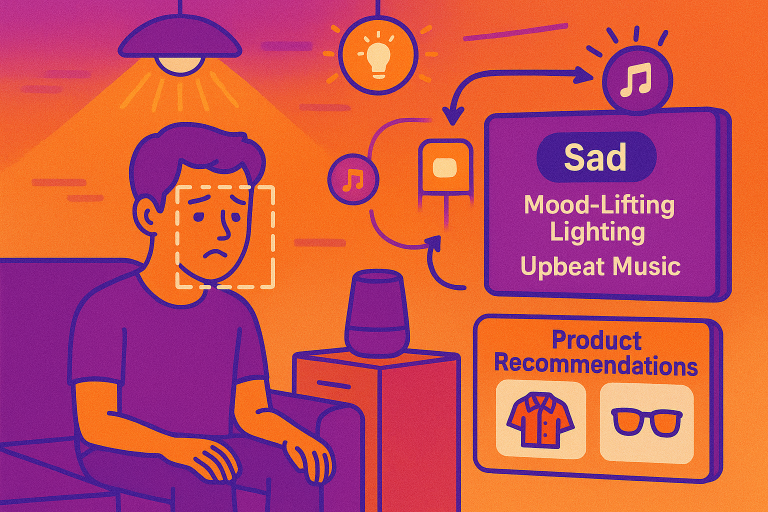How AI-Powered Emotional Product Recommendations Transform Shopping
Imagine browsing an online store that seems to know exactly how you’re feeling today. You’re feeling a bit down, and suddenly you see cozy comfort products, mood-boosting music recommendations, or perhaps a cheerful accessory that brings a smile to your face. This isn’t science fiction—it’s the emerging reality of emotional product recommendations powered by artificial intelligence.
AI systems are becoming increasingly adept at recognizing human emotions and using that information to suggest products that resonate with our current emotional state. This technological advancement is transforming the shopping experience for consumers while providing businesses with powerful new ways to connect with their customers on a deeper level.

Let’s explore how this emotional intelligence technology works, its real-world applications, and what it means for the future of retail.
The Science Behind Emotional Product Recommendations
At its core, emotional product recommendation technology relies on a field called affective computing—the study and development of systems that can recognize, interpret, and process human emotions. These systems use various signals to determine a person’s emotional state and then map those emotions to products that might resonate with that particular mood.
Affective Computing Technologies
Modern AI systems use multiple approaches to detect emotions:
- Facial expression analysis: Advanced computer vision algorithms can detect micro-expressions and facial movements that indicate emotions like joy, surprise, sadness, or frustration.
- Voice tone detection: Speech recognition systems analyze pitch, pace, volume, and other vocal characteristics to identify emotional states during verbal interactions.
- Text sentiment analysis: Natural language processing examines the emotional content of written communication, including search queries, reviews, and chat interactions.
- Physiological signal processing: Some systems can interpret physical signals like heart rate, skin conductance, or even brain activity through wearable devices to infer emotional states.
These technologies work together to create a comprehensive picture of a person’s emotional state at any given moment.
From Emotion Detection to Product Matching
Once an AI system has identified a user’s emotional state, it needs to connect that information to relevant product recommendations. This process involves several sophisticated components:
| Component | Function | Example |
|---|---|---|
| Emotional response mapping | Categorizes emotions into actionable patterns | Recognizing that excitement might lead to impulse purchases |
| Product attribute tagging | Associates products with emotional qualities | Tagging products as “comforting,” “energizing,” or “luxurious” |
| Contextual relevance algorithms | Considers situation alongside emotion | Different recommendations for someone who is happy because of a promotion vs. a date |
| Feedback loops | Refines recommendations based on user responses | Learning that a user responds well to humor when stressed |
The true power of these AI systems comes from their ability to learn and improve through continuous feedback. Each interaction provides more data, making future recommendations increasingly accurate and personalized.
Real-World Applications of Mood-Based Recommendations
Emotional product recommendations are already making their way into various consumer-facing businesses, creating new opportunities for meaningful connections between brands and their customers.
Retail and E-commerce Implementations
The retail sector has been quick to adopt emotional AI capabilities:
- Online shopping mood filters: Some e-commerce platforms now allow users to browse products based on mood rather than just category or price. A person can select “energizing” or “relaxing” to find products that match their desired emotional state.
- In-store emotional response systems: Physical retailers are experimenting with smart mirrors and digital displays that detect shopper emotions and adjust product showcases accordingly.
- Post-purchase emotion tracking: Brands track emotional responses to purchases to refine future recommendations and identify potential issues before they lead to returns.
- Conversion optimization: Retailers using emotional AI report significant improvements in conversion rates (typically 10-30%) by aligning product suggestions with customer moods.
A major beauty retailer implemented an emotional recommendation system that resulted in a 23% increase in average order value by suggesting products that matched customers’ self-reported mood states. Customers were offered a quick “mood quiz” that helped the system understand their current emotional needs.
Entertainment and Media Applications
The entertainment industry has embraced emotional AI with particular enthusiasm:
- Mood-based content recommendations: Streaming services suggest movies and shows based on the viewer’s detected or self-reported emotional state.
- Dynamic playlist generation: Music services create playlists that either match or intentionally shift the listener’s mood.
- Emotional response to advertisements: Marketers measure emotional reactions to ads and adjust campaigns based on what resonates emotionally.
- Personalized storytelling: Some interactive content adapts narrative elements based on the viewer’s emotional responses.
For example, a leading music streaming platform now offers “mood concierge” features that detect subtle emotional cues in listening patterns and voice interactions to suggest the perfect soundtrack for any moment.

Benefits for Consumers and Businesses
The rise of emotional product recommendations creates significant advantages for both consumers seeking more meaningful shopping experiences and businesses looking to build deeper customer relationships.
Enhanced Customer Satisfaction and Loyalty
For shoppers, emotionally intelligent recommendations can transform the shopping experience in several ways:
- Increased product relevance: Recommendations that consider emotional state are inherently more personalized and therefore more useful than those based solely on browsing history or demographics.
- Emotional connection to brands: Companies that acknowledge and respond to customer emotions foster stronger emotional bonds and brand loyalty.
- Reduced decision fatigue: When faced with too many choices, consumers can experience decision paralysis. Emotional recommendations narrow options to those that truly resonate at a given moment.
- Higher post-purchase satisfaction: Products selected to match emotional needs tend to result in greater satisfaction and fewer returns.
“When brands understand not just what I want but how I feel, the shopping experience becomes much more meaningful and I’m less likely to experience buyer’s remorse.” – Consumer Experience Researcher
Business Performance Improvements
For businesses, implementing emotional AI can drive significant performance metrics:
| Business Metric | Typical Improvement | Why It Happens |
|---|---|---|
| Conversion rates | 15-25% increase | Emotionally relevant products resonate more strongly with shoppers |
| Average order value | 10-30% increase | Emotional connections reduce price sensitivity and encourage complementary purchases |
| Return rates | 8-17% reduction | Products that match emotional needs create higher satisfaction |
| Customer lifetime value | 20-40% increase | Emotional understanding builds lasting loyalty and repeat business |
The data clearly shows that businesses investing in emotional intelligence technologies see substantial returns across key performance indicators.
Privacy and Ethical Considerations
While the benefits of emotional product recommendations are compelling, this technology also raises important questions about privacy, consent, and the potential for manipulation.
Data Protection and Consent
Companies implementing emotional AI must carefully address several privacy concerns:
- Transparent emotion tracking practices: Users should always be clearly informed when their emotional responses are being monitored.
- Opt-in requirements: Explicit consent should be obtained before collecting emotional data, with easy options to revoke permission.
- Data anonymization techniques: Emotional data should be anonymized wherever possible to protect user privacy.
- Regulatory compliance: Systems must adhere to regulations like GDPR, which specifically addresses biometric data (including emotional expressions).
Leading companies in this space have adopted privacy-by-design principles, ensuring that emotional data is protected, anonymized, and used only for its intended purpose.
Potential for Manipulation
The ability to detect and respond to emotions also creates the potential for manipulation:
- Emotional vulnerability concerns: People in certain emotional states may be more vulnerable to suggestion.
- Safeguards against exploitation: Ethical companies implement guidelines against targeting people in vulnerable emotional states.
- Ethical advertising standards: Industry associations are developing standards for appropriate use of emotional AI in marketing.
- Consumer education initiatives: Educating shoppers about emotional AI helps them make informed choices about engaging with these systems.
The most responsible companies view emotional AI not as a tool for manipulation but as a way to better understand and serve genuine customer needs—creating win-win scenarios rather than exploitative ones.
Future of Emotional AI in Shopping Experiences
As technology advances, emotional product recommendations will become more sophisticated, nuanced, and integrated into our daily lives.
Emerging Technologies and Integration
Several technological developments will shape the future of emotional product recommendations:
- Multi-modal emotion detection: Future systems will combine facial, vocal, textual, and physiological signals for more accurate emotion recognition.
- AR/VR emotional experiences: Virtual and augmented reality will incorporate emotional feedback, creating immersive shopping experiences that respond to emotional cues.
- IoT and smart home emotional context: Connected devices throughout our homes will understand environmental factors affecting our emotions and adapt product recommendations accordingly.
- Cross-platform emotional profiles: With appropriate privacy controls, our emotional preferences might follow us across different shopping platforms for consistent experiences.
Toward True Emotional Intelligence
The most exciting developments will move beyond basic emotion detection toward deeper emotional understanding:
- Beyond basic emotion detection: Future systems will recognize complex emotional states beyond the basic six emotions (happiness, sadness, anger, fear, disgust, surprise).
- Understanding complex emotional states: AI will recognize nuanced emotions like nostalgia, anticipation, contentment, or melancholy and their implications for product preferences.
- Cultural variations in emotional expression: Systems will become more adept at understanding how emotions are expressed differently across cultures.
- Context-aware emotional recommendations: AI will consider the wider context of a person’s life situation when interpreting emotions and making recommendations.
As these systems become more sophisticated, they’ll create increasingly personalized shopping experiences that feel less like algorithmic suggestions and more like recommendations from someone who truly understands you.
Conclusion
Emotional product recommendations represent a significant evolution in how we shop and how businesses connect with customers. By understanding not just what customers want but how they feel, AI-powered recommendation systems create more meaningful, satisfying shopping experiences.
While challenges around privacy, ethics, and emotional complexity remain, the potential benefits for both consumers and businesses are substantial. Companies that thoughtfully implement these technologies—with proper attention to ethical considerations and genuine customer benefit—will likely gain significant competitive advantages in the years ahead.
As emotional AI continues to evolve, we can expect shopping experiences that feel increasingly intuitive, supportive, and aligned with our authentic needs—not just what we want, but what will truly make us happy.




